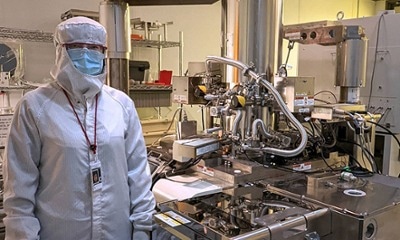Advances in wireless communication, imaging, atomic clocks, and other fields may be aided by a novel device for producing microwave signals.

Yang He ’20 (Ph.D.), an electrical and computer engineering postdoctoral scholar, stands beside an electron beam lithography system used to develop new microcomb technology. Image Credit: University of Rochester
Photonic devices called frequency combs create numerous evenly spaced laser lines, each locked to a particular frequency to create a comb-like shape. Scientists have been working to miniaturize the method so they can use it on microchips since it can be used to produce high-frequency, reliable microwave signals.
The ability of scientists to speed up the tuning of these microcombs to make them useful has been constrained. However, a group of scientists under the direction of Qiang Lin, a professor of electrical and computer engineering and optics at the University of Rochester, described a novel high-speed tunable microcomb in Nature Communications.
One of the hottest areas of research in nonlinear integrated photonics is trying to produce this kind of a frequency comb on a chip-scale device. We are excited to have developed the first microcomb device to produce a highly tunable microwave source.
Qiang Lin, Professor, Electrical and Computer Engineering and Optics, University of Rochester
The device, a lithium niobate resonator, enables users to control bandwidth and frequency modulation rates at rates that are orders of magnitude quicker than those of conventional microcombs.
The device provides a new approach to electro-optic processing of coherent microwaves and opens up a great avenue towards high-speed control of soliton comb lines that is crucial for many applications including frequency metrology, frequency synthesis, RADAR/LiDAR, sensing, and communication.
Yang He, Study First Author and Postdoctoral Scholar, University of Rochester
Raymond Lopez-Rios, Usman A. Javid, Jingwei Ling, Mingxiao Li, and Shixin Xue are other coauthors from Lin’s team.
The project involved faculty and students from the University of Rochester’s Departments of Electrical and Computer Engineering and Optics, as well as the California Institute of Technology. The Defense Threat Reduction Agency, the Defense Advanced Research Projects Agency, and the National Science Foundation contributed to the research.
Journal Reference
He, Y., et al. (2023) High-speed tunable microwave-rate soliton microcomb. Nature Communications. doi:10.1038/s41467-023-39229-3